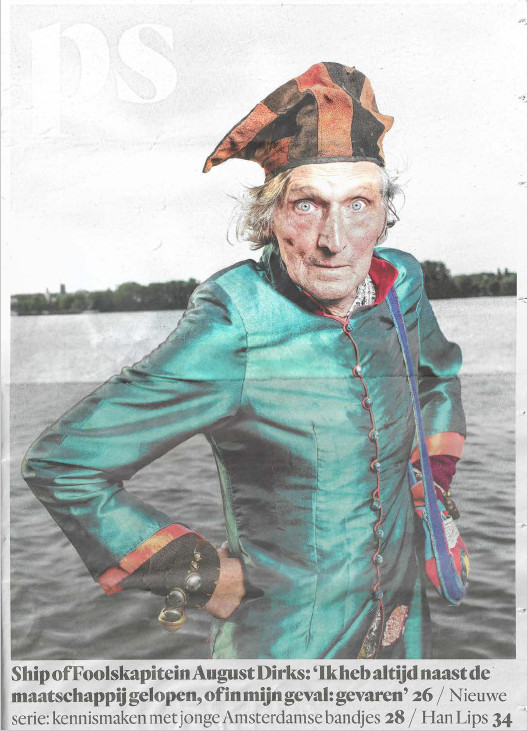The Captain’s Log Book 42
Tuesday, July 19, 2022
Amsterdam
52º20´518´´ North, 004º54´29´´ East
HET PAROOL
August Dirks (70) was for many years the captain of the Azart – Ship of Fools and wanted to sail his ship to the Uluruberg in Australia for her last voyage. But along the way it turned out he was terminally ill. A retrospect. “You are the fools, with all your rules.”
MY LIFE WAS A WORK OF ART
When August Dirks (1952) talks, his hands wave back and forth and bells ring on his wrists. The dark blue nail polish is peeling off his nails. “So your name is Dirks too?” he asks as I enter, his bright blue eyes squinting.
For many years August Dirks was the captain of the Azart, also known as The Ship of Fools. For thirty-three years Azart sailed around the world as a traveling theater with a changing crew of actors, artists and musicians. They performed absurdist performances for children and adults in the ports of Cape Verde, Greece and Russia. Until September 12, 2021. “The miracle became true: The Ship of Fools is on the beach”, Dirks wrote in his logbook. “Fifty-seven nautical miles south of the equator and a hundred and fifty meters beyond the Pacific Ocean.” In three acts he describes the last journey of the Azart. “A happy end. A very expensive performance but very memorable, all the more so because the ship is on wheels again and thus returns to its historical origin as a wheel barge or ship cart, in other words the most exuberant cart of the carnival parade.”
It sounds like the end of a picaresque novel. Is this the end of the adventure?
“It’s over for me. I have nothing to do there anymore. But for Azart it is a new beginning. She is now located near Manta, Ecuador, in a fishing village. We put her there on the beach. A theater group from Quito has taken over. There is a tribune in front of it. In thirty years she will still be there, that has been agreed with the authorities.”
Did it hurt to say goodbye?
“It came a little too early for me. But that was due to my health. I got cancer. Then the tumor had to be cut out. I walk a little more difficult and can no longer move really well. Then you no longer can’t sail with a boat So that makes it easier to accept that the ship finds such a nice destiny. The doctor gave me three months, that’s almost a year and a half ago. So far, the treatment is working.”
Do you see yourself as an artist or as a rebel?
“Both, I guess. I’ve shaped my own life, built my own utopia. I’ve always been on the outside of the society.
When did that start?
“I was a student of Russian in Amsterdam and had the idea to start a kind of exchange office for artists from Amsterdam and Moscow during perestroika. We called it CIRC. At that time, Russian artists were allowed to go abroad for the first time in seventy years, on invitation. But it didn’t matter who the invitation came from, so I just wrote them myself as a poor student. We held a squat office with some other students. I did that for a few years, until my father died. My brothers and sisters put the inheritance in their mortgage, very clever. I bought a ship for my 60,000 guilders. That’s how it started.”
Why a ship?
“Because of Amsterdam’s history. I saw an old barge in Amsterdam Noord. So beautiful. It was a ship from around 1920, when ships were still beautiful. Romantic.”
You bought an old herring logger from 1916 with the idea of turning it into a sailing opera ship and taking it to Russia. And then?
“Then we couln’t sail. For five years, we were seized on the KNSM island. The first opera went bankrupt. We had some problems with a lawyer and the promised subsidy for our tour to Moscow did not go through. With hindsight, you could say it was good, because I dit not know how to sail at all at that time. I put a few pigs on the ship so that it would become unattractive to buy. And then we started a nightclub on the island with illegal Russian vodka and cabaret. With the money we earned I was able to fix up the old lady enough to go to sea. We sailed around for fifteen years and played shows everywhere and nowhere. And then we were seized again in 2000, because of a problem near Alkmaar. Fortunately, we were then able to enforce that we could be on Azart Square, on our old place. We had no right to moor there, but also no hassle with the harbor service. Of course they couldn’t refuse, that square was named after us.”
Why did you want to try again to get the Azart back to sea?
‘Why give it up if it still has a bright future? That’s the question you need to ask.”
I think a lot of people would have given up. Why did you continue to believe in the floating theatre?
“Yes, what else could you do? The ship is seized, but that is a matter of negotiation. It’s all nonsense. That’s the secret of Azart: she looks like floating scrap, nobody wants to buy it. But you actually have an enormous power. I compare it with the Jehovah’s witnesses with their shoes: once in the door you can’t get it off. It’s a blue clog of 180,000 kilos. And in the meantime you do the nicest things when you are on the quay. I see the ship as a free stage that you can place wherever you want. It’s also a mobile sculpture that you decorate as you please.
“Do you see it as an art project?
“Yes. It is playing with geography. You’re always in a fantastic environment, every time you’re part of a different landscape: a remote industrial place, in the middle of a tropical river in Suriname or in a medieval Italian village. There’s always something special about it.”
That was the goal in the first place?
“Sailing. Get out. The Cuban Missile crisis had freed me of the ambition to achieve anything in society. I was an adolescent and I thought: it makes no sense, they will shoot each other anyway. Humanity doesn’t learn. From a social point of view, I gave up quite early. In retrospect you can say that I was sixty years too early
“How did the Azart become the Ship of Fools?
“When I was bankrupt, I came across the book The Guild of the Blue Barge, by Herman Pleij. It describes a sermon from the Middle Ages about The Ship of Fools. It was a warning: on that barge there are people who do not fit in the society, the fools, those who are to be sent away. Many artists were inspired by that text. The book Das Narrenschiff by Sebastian Brant is based on it, as is the painting The Ship of Fools by Jheronimus Bosch. I realized it didn’t matter, al these problems with lawyers and withdrawn subsidies. Fools don’t need money, they live on nothing. Give them every now and then some wine.
“So what made this image so appealing to you?
“I took it as a challenge. Get out of this society. You are the fools, with your rules and problems, and permanent crimes. It is total destruction. We are the ones seeking salvation, you are doomed.
“The role of a jester is also to hold up a mirror to society.
“Exactly. I wanted people to ask themselves, am I fool, or is it you? You’re stuck in a traffic jam to work, are you struggling to pay the mortgage. I’m in some nice town in the sun an opera lesson. I’m not the fool. That was the mirror.
“Is humor just a means or an end?
“If you want to attract as much audience as possible, you have to make it a bit of a comedic show. Humor also makes it easy to be accepted. A madman with big ears, bells on his wrists and in funny clothes isn’t seen as a threat. The goal was the smile”.
Are you a fool?
“No, of course not. I had to run a ship, negotiate with the port services, direct people, set up plays, map out routes. You can’t do that if you are really crazy. By the way, in today’s society all this became completely unthinkable. All this time, I slipped with that ship through the loopholes of the law
“Have you never thought: why don’t I just have an upstairs apartment in Amsterdam?
“No, certainly not. I always thought of houses like this as a kind of coffin. You know those cemeteries in southern Europe? You get pushed in like that. It’s the same.
“But now you’re there.
“Yeah, I accept it, I have to.
“Are you afraid of dying?
“No. Maybe a bit for the pain. But they have resources for that, these days. It’s pretty banal to die of lung cancer at seventy, don’t you think? Finally, I’m recognized as an ordinary person. I thought I was special, but it’s the environment itself that’s so weird, that it makes me seem weird. But I’m actually a pretty normal person. I know what’s good, I know what’s beautiful and what’s important to someone Most people don’t know that. It’s that simple. Then I’m not me the fool, but you.”
August Dirks (70) was for many years the captain of the Azart – Ship of Fools and wanted to sail his ship to the Uluruberg in Australia for her last voyage. But along the way it turned out he was terminally ill. A retrospect. “You are the fools, with all your rules.”




.jpg)
You are often in my thoughts but you have never left my heart